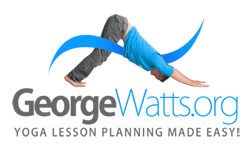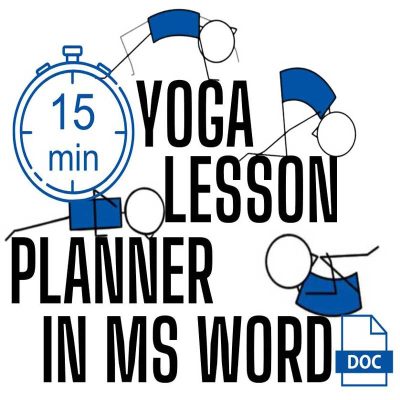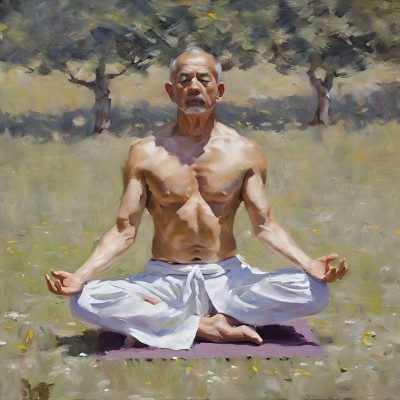How I Teach Headstand (Sirsasana): Step-by-Step Guide, Teaching Tips & 30 Modifications for Beginner, Intermediate & Advanced Students

George in Headstand
Greetings, my lovely Yogis, Yoginis, and Yoga teachers. I’m George Watts, a BWY yoga teacher and creator of the Online Yoga Lesson Planner.
Headstand (Sirsasana) is often called the King of Asanas because of its powerful effects on strength, focus, and balance.
However, for many students, the thought of going upside down can be intimidating. As a yoga teacher, it’s essential to break down the pose into manageable steps, offer modifications, and create a safe and supportive learning environment.
In this post, I’ll share step-by-step instructions, key alignment cues, and 30 modifications (beginner, intermediate, and advanced) to help students build confidence and control in their Headstand practice.
8 Steps for Teaching Headstand (Sirsasana)
- Start in a Kneeling Position – Sit on your heels and take a moment to centre your breath.
- Create a Stable Base – Interlace your fingers, placing your forearms on the mat shoulder-width apart. The crown of your head should rest lightly on the floor with the hands cupping the back of the head.
- Lift the Hips – Straighten the legs and walk the feet closer to your body, stacking the hips over the shoulders.
- Engage the Core – Activate the core muscles to maintain control and stability before lifting off.
- Bend the Knees and Lift One Leg – Bring one knee toward the chest, followed by the other, keeping balance in the forearms.
- Extend the Legs Upward – Once balanced, straighten the legs slowly toward the ceiling, ensuring the spine remains long and aligned.
- Hold and Breathe – Maintain steady breathing, engaging the core and pressing into the forearms for stability.
- Exit with Control – Lower the legs slowly, one at a time, and rest in Child’s Pose (Balasana) to counter the inversion.
5 Key Alignment Cues for Headstand
- Keep the weight evenly distributed between the forearms rather than relying on the head.
- Engage the core muscles to maintain balance and avoid excessive arching in the lower back.
- Shoulders stay active by pressing firmly into the mat, creating stability in the upper body.
- Legs remain strong and engaged, reaching toward the ceiling for better alignment.
- Breath remains steady and controlled, allowing for focus and relaxation in the posture.
30 Modifications for Headstand (Sirsasana)
I love learning new modifications for a pose!
Why do I do this when I probably won’t use most of them in a class?
Mainly because it gives me more confidence when rocking up to my yoga classes. When I see a student who needs a modification, I walk up to them, and demonstrate an appropriate one for them. It could be a beginner, intermediate or advanced modification depending on their experience.
I’ve also discovered that learning lots of modifications helps me become better at teaching the standard pose. All that information is swirling around somewhere in my little head, and finds a way to come out when needed in a class.
Here are 30 modifications for you!
Scan through them, pick ones that resonate with you, then close your eyes and imagine teaching the modification in your class. Visualisation is a fabulous mental tool for yoga teachers! Try my 3-step visualisation tactic to rehearse your next yoga class.
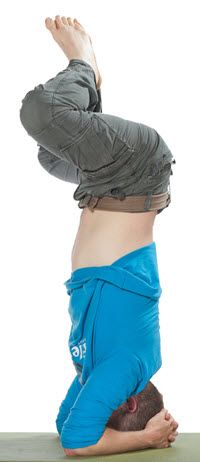 George in Headstand With Butterfly Legs | 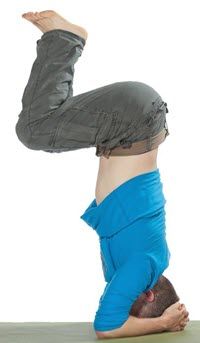 George in Half Headstand |
10 Beginner Modifications for Headstand (Sirsasana)
Beginner Modification 1: Wall Support
Practice Headstand near a wall for extra stability. This helps students build confidence while preventing falls.
Beginner Modification 2: Dolphin Pose Hold
Have students hold Dolphin Pose to strengthen the shoulders and prepare for Headstand. This builds a solid foundation before attempting the inversion.
Beginner Modification 3: Knees to Chest First
Instead of lifting both legs at once, students can bring their knees to their chest first. This makes balancing easier and reduces the fear of falling.
Beginner Modification 4: Half Headstand
Keep the knees bent and the feet hovering above the floor rather than extending the legs. This modification builds strength while maintaining control.
Beginner Modification 5: Use a Yoga Block for Hands
Placing a block between the hands can help maintain proper wrist and forearm alignment. This prevents the elbows from splaying out.
Beginner Modification 6: Partner Assistance
A teacher or partner can support the legs gently as the student lifts into Headstand. This provides a feeling of security and control.
Beginner Modification 7: Focus on Core Engagement
Encourage students to build core strength with preparatory poses like Boat Pose (Navasana). This helps develop stability needed for Headstand.
Beginner Modification 8: Keep Feet on the Ground
Instead of lifting the legs, students can practice pressing into the forearms while keeping feet on the mat. This helps strengthen the upper body and build confidence.
Beginner Modification 9: Practice Against a Couch or Soft Surface
Using a couch or cushioned surface behind the student provides extra security if they lose balance. This reduces the fear of falling.
Beginner Modification 10: Short Hold Time
Encourage students to hold the pose for just a few seconds before coming down. Gradually increasing hold time builds endurance safely.
10 Intermediate Modifications for Headstand (Sirsasana)
Intermediate Modification 1: Away from the Wall
Move away from the wall and practice lifting into Headstand freely. This helps develop independent balance.
Intermediate Modification 2: Tuck to Straddle Entry
Instead of lifting both legs together, enter Headstand by tucking the knees and then opening into a straddle before lifting up.
Intermediate Modification 3: Controlled Leg Lifts
Practice slow and controlled leg lifts rather than kicking up. This improves balance and strength.
Intermediate Modification 4: Focus on Breathwork
Encourage students to hold Headstand while maintaining steady Ujjayi breathing. This enhances focus and control.
Intermediate Modification 5: Practice Lifting One Leg at a Time
Instead of lifting both legs simultaneously, students can practice lifting one at a time. This improves balance awareness.
Intermediate Modification 6: Add Shoulder Shrugs
Gently pressing the shoulders up and down while in Headstand strengthens the upper body.
Intermediate Modification 7: Hold for Longer Durations
Increase hold time to 30–60 seconds to build endurance and stability.
Intermediate Modification 8: Focus on Drishti (Gaze Point)
Fixing the gaze at one point helps improve concentration and balance in the pose.
Intermediate Modification 9: Incorporate Core Engagement Exercises
Use leg lifts and pike exercises to improve strength for maintaining balance.
Intermediate Modification 10: Hands-Free Variation
Instead of clasping hands together, try placing the forearms parallel for a different arm variation.
10 Advanced Modifications for Headstand (Sirsasana)
Advanced Modification 1: Press Up from Pike
Instead of jumping, enter Headstand from a pike press for maximum control.
Advanced Modification 2: Lotus Legs in Headstand
Cross the legs into Lotus Pose (Padmasana) while holding Headstand.
Advanced Modification 3: Eagle Legs in Headstand
Wrap the legs into Eagle Pose (Garudasana) while balancing.
Advanced Modification 4: Headstand to Handstand Transition
Slowly transition from Headstand into a full Handstand for an advanced challenge.
Advanced Modification 5: One-Legged Headstand Hold
Lift one leg straight up while keeping the other extended parallel to the floor.
Advanced Modification 6: Twisting Headstand
Gently twist the torso while keeping the legs stable in the air.
Advanced Modification 7: No Wall, No Spotter
Hold a freestanding Headstand with no external support.
Advanced Modification 8: Use Less Arm Pressure
Gradually reduce arm pressure and rely more on core engagement.
Advanced Modification 9: Hold for Over a Minute
Extend hold time to 90+ seconds to build strength and endurance.
Advanced Modification 10: Controlled Lower to Crow Pose
Slowly transition from Headstand into Crow Pose (Bakasana) with control.
George’s Conclusion
Well, there you have it, my lovely fellow yoga teacher.
Teaching Headstand (Sirsasana) requires patience, guidance, and a structured progression to ensure students feel safe and confident. By keeping a few modifications up your sleeve, knowing the proper alignment cues, and not being afraid to use breathwork, you can help students build a strong foundation and deepen their inversion practice over time.
Oh yes, I almost forgot, click here for 10 beginner yoga lesson plans with peak poses which are ideal “themed” yoga lesson plans.
And click here for an article I wrote called: 1001 Yoga Class Planning Tips & Handouts For Yoga Teachers.
If you want to create yoga lesson plans quickly and easily, take a quick peek at my Online Yoga Lesson Planner.
Hey, while you’re here, you might as well get your hands on 37 free Yoga lesson plans.
37 Free Yoga Lesson Plans
Below are 37 free downloadable yoga lesson plans that I’ve created for my own yoga classes using the Online Yoga Lesson Planner. Feel free to use them for your own yoga classes, or as inspiration to come up with your own yoga class themes.
Become A Peaceful Warrior Yoga Lesson Plan
Caterpillar To Butterfly Yoga Lesson Plan
How Heavy Is This Glass Of Water Yoga Lesson Plan
Surrender To Slowness Yoga Lesson Plan
You Don’t Need Permission To Shine: Just Show Up, Shine & Be Yourself
Abiciously Delicious Core Yoga Lesson Plan
Chair Yoga For Seniors Lesson Plan
Sun Salutations Chair Yoga Lesson Plan
Sun Salutations A Yoga Lesson Plan
Sun Salutations B Yoga Lesson Plan
Sun Salutations C Yoga Lesson Plan
Camel Peak Pose Yoga Lesson Plan
Downward Facing Dog Pose Variations Lesson Plan
Plank Peak Pose Yoga Lesson Plan
Revolved Poses Yoga Lesson Plan
Twists-Themed Yoga Lesson Plan: 41 Twist Poses To Whip Your Student’s Cores Into Shape
Yoga Therapy: Arthritic Spine Yoga Lesson Plan
Yoga Therapy: Asthma Yoga Lesson Plan
Yoga Therapy: Hips Yoga Lesson Plan
Yoga Therapy: Opening Upper Back, Neck & Shoulders Yoga Lesson Plan
Yoga Therapy: Restorative Yoga Lesson Plan
